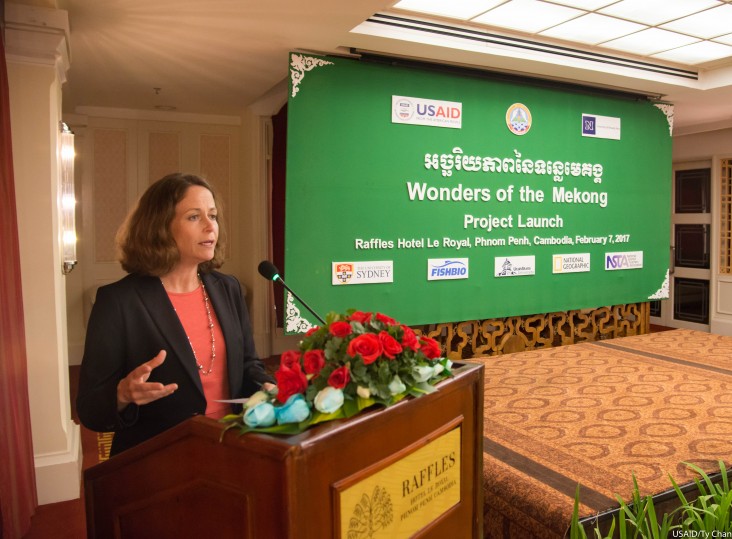
(as prepared for delivery)
- Your Excellency Nao Thuk, Secretary of State, Ministry of Agriculture, Forestry and Fisheries
- Development partners
- Ladies and Gentlemen
Thank you for the opportunity to be with you for the launch of the “Wonders of Mekong project: A Foundation for Sustainable Development and Resilience”. It is my pleasure to have another opportunity to celebrate our partnership between the Royal Government of Cambodia and the United States. The goal of this particular project is to research and document the internationally significant natural and human capital assets of the Mekong and to demonstrate how conservation, that is, stewardship of Cambodia’s river and lake systems, is vital to Cambodia’s economic growth and the well-being of its people. We will need your dedication, determination and a real commitment to secure the success of this project.
Our coming together today provides a great opportunity to reflect on how truly wonderful the Mekong is, on the advances Cambodia is making for its conservation and on how together we will continue to strengthen the health and vibrancy of the river for the people of Cambodia, the region and even the globe.
The Mekong is the most productive river on Earth, a biodiversity hotspot that supports over 70 million people. Arising from the glaciated mountains of the Tibetan Plateau, the Mekong River has been the lifeblood of great civilizations past and present. Its fertile delta helps to feed the world’s growing appetite for rice, and its many waterways have provided low-cost transport of goods and services for millennia. Of all countries touched by the Mekong and its vibrant role in the southeastern mainland of Asia, none is more closely intertwined with the Mekong than Cambodia. The wondrous Mekong cuts a path right through the heart of Cambodia and the ebbs and flows of the Great Tonle Sap are the heartbeats of the country. The Mekong system is central to providing for the food and livelihoods of not only the rural poor, but also for the burgeoning Cambodian economy. For example, tourism is on the increase, including indigenous tourism enterprises. These tourists from around the region are coming for the famed wonders of history, culture and nature.
Today, the river supports a fishery valued at between $5.6 and $9.4 billion per year. Overall, the river- its ecosystems services valued at hundreds of billions of dollars - supports modern day cities like Phnom Penh, Siem Reap, and its agriculture, aquaculture, and hydropower. Although Cambodia is a relatively small country, the abundant water from the Mekong River is associated with some of Southeast Asia’s richest areas of biodiversity and largest tracts of forest. The Mekong is truly a river of wonder, but also a river facing many complex challenges from a growing human population to accelerating regional development.
I would like to take this opportunity to recognize the advances in conservation that the Cambodian Government and its people have made. Recently, I was in Steung Treng and Kratie where I was able to see firsthand the vibrancy of the river and its bounty. A vibrancy that local communities have contributed to over centuries.
Not long ago, there was great concern about the decline of the Irrawaddy dolphin and now we have seen the birth of 11 dolphin calves. Challenges remain and we are hopeful for the future of this critically endangered dolphin based on this slight uptick in the dolphin population.
There is further hope in maintaining the Mekong’s future as the government has committed to not building any dams on the mainstream of the Mekong.
Conservation is important to all of us as healthy natural systems provide goods and services that sustain life and improve human wellbeing. Working together, through the Wonders of the Mekong partnership, we can maintain the ecological, cultural, and economic integrity of the most important river and delta system in the world.
That means that we will work to improve water quality so that Irrawaddy dolphin populations continue to grow. It means working with the government to explore economic growth options related to ecosystem services. In many cases, integrated water management, maintenance of ecosystem services, and protection of biodiversity are similar paths to the same end – a more sustainable future for the lower Mekong River Basin and its people. Conservation and development can go hand-in-hand.
Once again, thank you for inviting me to join you today. The United States, through USAID’s support, is proud to partner with Cambodia to the benefit of all Cambodians.
Related Speeches
- Remarks by Polly Dunford, Mission Director, USAID Cambodia, Launch Event of Feed the Future Cambodia Harvest II
- Remarks by Christina Lau, Deputy Director, Office of Public Health and Education, USAID/Cambodia, Opening Ceremony of the Kick-Off Workshop for “One Health Workforce”
- Remarks by Veena Reddy, Deputy Mission Director, USAID Cambodia, EPIC Showcase







Comment
Make a general inquiry or suggest an improvement.